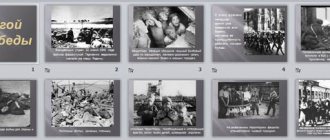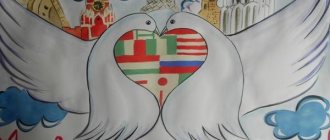Lesson summary with presentation on the topic: Autumn for 2nd grade
Lesson for primary school students (grades 1-2) “Golden Autumn”
Author: Dailidenok Lyubov Evgenievna, MAOU of the city of Kostroma “Gymnasium No. 25” Description: The material is intended for primary school teachers, educators and parents. Purpose of the lesson: To consolidate students’ knowledge about the season of autumn. Objectives: 1. Develop students' communication skills. 2. Getting acquainted with the paintings of great Russian artists, give students the opportunity to reflect on the question “What is the beauty of autumn?” 3. Using visual methods to promote the development of a holistic perception of schoolchildren. Equipment used:
pieces of paper, pens (pencils), presentation.
Organizational point: Hello guys. I'm glad to see your happy faces, guys. Let's look into each other's eyes, feel warmth and support. Lesson progress: Teacher:
Guys, I suggest you guess the riddle: The days have become shorter, the nights have become longer, Who can say, who knows, When does this happen?
Answer: (Autumn) Teacher:
well done guys, today we will talk to you about the time of year “Autumn”.
AUTUMN LEAVES The leaves are dancing, the leaves are spinning, and they lie under my feet like a bright carpet. It’s as if they are terribly busy, Green, red and gold... Maple leaves, oak leaves, Purple, scarlet, even burgundy... I throw the leaves up at random - I can also arrange leaf fall! (author Yu. Kasparova) Who can tell me guys the autumn months? Children's answers (September, October, November) Teacher:
that's right, well done. But these months used to have other names. September - gloomy
October is dirty
November - half-winter
Work in groups
And now look at the paintings of Russian artists,
think, discuss in groups and answer the question “What is the beauty of autumn?”
You are given 4 minutes to discuss. Responses from each group are heard
Teacher:
There are many proverbs about autumn, here are a few of them: - One leaf fell from a tree - wait for autumn - There is no turning from autumn to summer. - Autumn is boastful, but spring is fair. — In September, the tit asks autumn to visit And also riddles about autumn (presentation slide)
Teacher:
Guys, let's think about how inanimate nature changes in the fall?
Children's answers:
(Students characterize each feature) Sun (position above the horizon).
The sun rises lower and lower, the days become shorter. Air temperature (warm, cool, cold). The earth and air warm up less. It's getting colder. The first ice appears on the puddles. State of the sky (clear, cloudy, cloudy). The sky is increasingly covered with clouds and clouds. Precipitation (rain, sleet, sleet, snow). The rains become colder, heavier and snow begins to fall. Conclusion: What is the reason for the ongoing changes in inanimate nature? (In cold weather) Teacher:
Nature generously gives us its gifts in the fall.
Name the gifts of autumn. The guys' answers:
berries, mushrooms, etc.
Every year, various autumn competitions are held all over the world, for example, crafts made from natural materials, as in our school too. There are also competitions for the largest fruit or vegetable grown in your garden.
RESULT: What new did you learn in class today?
Answers from the guys
Did you like our lesson today? If yes, then draw a sun on a piece of paper, if not, then a cloud. Homework: collect a herbarium of autumn leaves. Autumn has a beautiful smile, Women have the kindest face in her, And in her dresses embroidered with gold, Happiness sparkles - joyfully, lightly. The leaves lie like silk on the roads, Children wander in the autumn park, You go around the familiar rapids, Gild the empty banks. Shine like a magical star in the middle of the night, Please don’t rush to leave, After all, you are a beautiful golden autumn, It’s not in vain that poems were written for you. Your aroma swirls and intoxicates, People without wine get drunk with you, And a passing traveler will not leave you - He will appreciate you with a tender glance. (author: Elena Stepanova)
Teacher:
Our lesson has come to an end.
Presentation on the topic: Golden autumn
We recommend watching:
Autumn holiday in 1st grade. Scenario Extracurricular activity on the topic: Autumn, 2nd grade Travel game in elementary school on the topic: Autumn Excursion to the school site, 2nd grade. Autumn
Similar articles:
Autumn holiday in elementary school. Mushrooms
Autumn Festival for high school students. Script and competitions
Autumn Festival in elementary school. Script, 1st grade
Class hour “Late Autumn”, 2nd grade
Autumn Festival in elementary school. Scenario with competitions
Presentation "Autumn"
Our presentation is devoted to the topic “Autumn”, which is studied in lessons on the World around us in the second grade. With the help of beautiful and bright slides, children are told about the phenomena that occur in living and non-living nature in the fall.
Examples of our presentation slides:
The structure of our presentation: 1. Poems by S. Yesenin 2. Autumn cooling 3. Frosts, frost 4. Autumn rains 5. Autumn fogs 6. Rare autumn thunderstorms 7. Wet snow 8. Freeze-up 9. Foliage changes color 10. Plants that do not change coloring in autumn 11. Migratory birds gather south 12. Animals store supplies 13. Animals change coats
Download for free and without registration:
| osen.pptx | 225 Downloads |
Other interesting presentations on this subject:
Beaver report
The largest rodents living on the planet are beavers (Castor). Their length reaches 130 cm, and their weight is from 20 to 30 kg. The beaver's tail, quite wide and flattened, is shaped like a boat oar and covered with horny formations similar to fish scales. Beavers lead a semi-aquatic lifestyle. The beaver family (Castoridae) includes only two species: the European beaver (Castor fiber) and the Canadian beaver (C. canadensis). They differ slightly, primarily in the width of the tail (the “Canadian” has it larger).
Report on the constellations of Orion and Scorpio A constellation is a group of stars, the shape of which people associate with some object, animal or hero, and which receives a corresponding name - for example, Gemini or Leo. Constellations and the stories behind them make it easier for people to find certain stars and have more fun remembering them.
Report “Animals and Plants of the Rainforest” The rainforest consists of numerous layers of a variety of evergreen plants. In the upper tier the trees reach 100 meters in height. Here you can also find palm trees - lianas, which, being the longest plants on Earth, grow 300 or even 400 meters.
Savannah Report In Spanish there is a word “sabana”, which means wild plain. It is from this word that the name of the tropical steppes - savannas - comes from. Savannas are located in the equatorial zones of the northern and southern hemispheres of the Earth.
Presentation “Structure of the human body”
Our presentation “Structure of the Human Body” will interestingly and captivatingly tell primary schoolchildren about what our body is made of, about the main internal organs, using beautiful, bright slides and explanations for them that are easy to understand for second-graders. The presentation contains interactive riddle slides with which children can test their acquired knowledge. Our presentation can be used not only in lessons on the surrounding world using Pleshakov’s textbook in 2nd grade, but also in any other lesson where basic concepts about the human body are studied.
Presentation “Tropics” Our presentation will introduce students to the geographical location of the tropics, the tropical climate, and talk about the natural areas included in the tropical zone. Children will look at amazing plants growing in tropical forests and learn about the animal world of this zone using the example of its most interesting representatives.
Presentation Bread is the head of everything The presentation “Bread is the head of everything” is intended for lessons on the world around us in elementary school using Vinogradova’s textbook (21st century program), but can be used in any other lesson or activity dedicated to bread.
Presentation on the topic my homeland
Our presentation is devoted to the topic “Homeland” based on the textbook “The World Around us” for Vinogradova’s 2nd grade, but can also be used in any other lessons at this age.
Presentation of "Savannah"
After watching our presentation, children will learn what a savanna is, where it is located and what its climate is like.
Presentation "Seas and Islands"
Our beautiful presentation explains in a simple and accessible way what islands are and how they differ from peninsulas. Children will visually explore the three properties of seas and learn about the different origins of islands. The teacher's story will be accompanied by a display of bright and interesting slides.
- < Back
- Forward >



